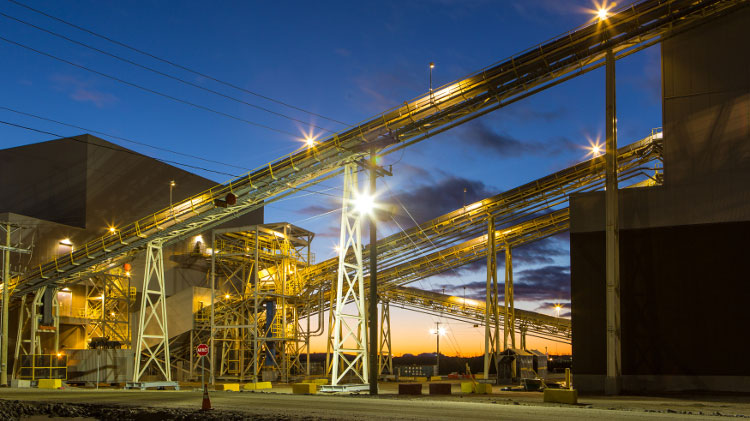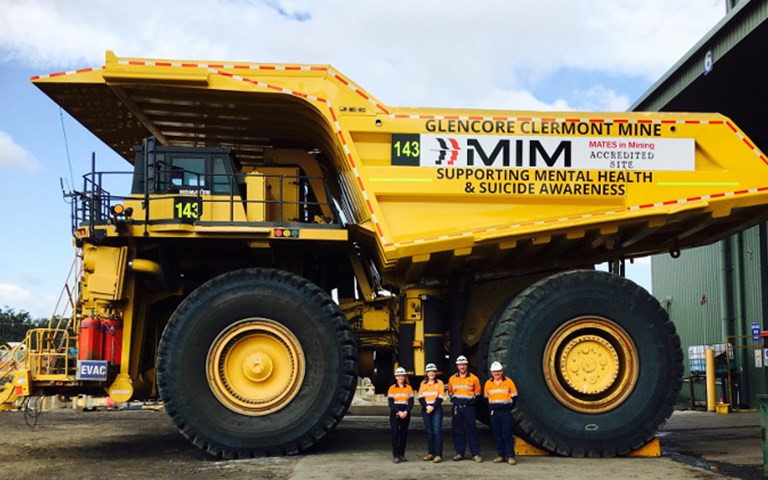The MATES in Mining suicide prevention program implemented by Glencore and other operators at their Australian mines asks miners to be their brothers' keeper. Courtesy of Glencore Coal Assets Australia
“Are you thinking about killing yourself?”
It is a simple, powerful question that is remarkable in its directness. It is shocking to hear, difficult to ask and can be nerve wracking to answer, but it is the key to a suicide prevention program seeing results in the mining industry in Australia.
In 2015, Glencore Coal Assets Australia’s general manager Kylie Ah Wong noticed there had been an increase in stress-related claims through workers’ compensation since 2005.
That same year, two Glencore employees in New South Wales took their own lives within a few months of each other. And her sites were not the only ones experiencing this.
“I remember being at an industry forum, and I was talking to one of my colleagues and I said, ‘Oh it’s really sad, one of our employees suicided.’ And he said, ‘Oh yeah, we had that last week,’ and I realized this is a lot more prevalent than we believe, we just don’t talk about it,” said Ah Wong.
Glencore offers employment assistance programs (EAP), but enrolment had stagnated. To Ah Wong, it was clear this was because of a central flaw in its approach: they rely on employees themselves – the large majority of them men – asking for help. “Throughout my whole journey, one of the things that’s become profoundly clear to me is that men don’t ask for help,” said Ah Wong. “We had to do something different.”
Then Ah Wong learned about MATES in Construction (MIC), a charity focused on reducing the disproportionately high suicide rates in the Australian construction industry by asking coworkers to look out for one another rather than asking people who are struggling to seek help for themselves.
Given that mining has similar demographics to the construction industry, Ah Wong felt MIC could easily translate. With funding from Coal Services Trust as well as Glencore, Ah Wong helped implement MATES in Mining (MIM) at two of Glencore’s mines, with the first training session at Clermont in February 2016 and at Glendell the following May. As word spread, more miners became interested in the program and MIM received funding from the Australian Coal Association Research Program, which allowed it to hire a project manager, Andrew McMahon, to work on the program full time.
“Our program significantly shifts the landscape by saying, let’s not focus on those that are doing it tough as our target, let’s focus it on everybody, because while blokes might be terrible at asking for help, they are absolutely brilliant at offering help to a mate,” explained McMahon.
How the program works
One of MIM’s first steps is to deliver a general awareness training session for everyone at a work site to give them the facts: according to the Australian Bureau of Statistics, in 2015 in Australia there were 12.6 suicides per 100,000 people, deaths by suicide occurred among males at a rate three times higher than that for females, suicide was the leading cause of death for males aged 15 to 44, and for every death by suicide, it is estimated that as many as 30 people attempted suicide. Many of these statistics track closely to those in the Canadian population.
Blue-collar workers, such as operators and labourers, are more likely to die by suicide than their white-collar counterparts and according to a Western Australian state parliamentary report, fly-in fly-out workers are more likely to have alcohol-related problems, feelings of isolation, financial pressure and high levels of stress, anxiety, depression and fatigue than other workers, all of which increase risk of suicide.
“We know that only seven out of 100 blokes who died by suicide in the construction industry in Australia put up their hand and asked for any kind of help before doing so, so if we continue to run programs that are focused on asking blokes to put up their hands, then we might save seven, but 93 will die,” said McMahon.
Related: Roy Slack of Cementation says frontline supervisors play a key role in establishing a safety culture
In the general awareness training, employees are told what warning signs to look for in their coworkers. Some employees volunteer to undergo additional training to become “connectors,” where miners are taught first how to listen. “For blokes in particular, we’re brilliant at solving problems and so we jump to solutions, but what most people need is to actually come up with it themselves,” explained McMahon.
Connectors are also taught how to ask that question – “Are you thinking about killing yourself?” – to a friend onsite they suspect may be having suicidal thoughts. “A direct question gets a direct answer,” said McMahon. Skirting around the question often allows people to avoid it.
Actually asking that question can be difficult. “I’ve done the training myself and asking even in a role play situation, I fumbled the words a couple of times before I got them out,” said Ah Wong. When the workers struggle with this, McMahon reminds them, “as much as you think it's really hard to offer help to a mate, it's much harder for your mate to ask for help.”
The last part of the connector training is teaching the volunteers how to connect their mate to help, and MIM ensures they get the support they need. “The health system can be a fairly big world that’s a bit scary to navigate, so our case managers will support people going through that,” said McMahon.
MIM also offers training based on Canada’s Applied Suicide Intervention Skills Training (ASIST), which is akin to suicide first aid. The primary goal of employees who complete the two-day training is to keep people safe.
With these various levels of training, the aim is to have a site where all employees are able to recognize the signs that suggest a coworker may be struggling, about 30 per cent of employees have undergone connector training and around 15 per cent have completed suicide first aid training. “Now that bloke who was alone and screaming for help but didn’t know how to ask for it, he’s actually surrounded by a whole heap of blokes who can offer help,” said McMahon.
Anthony Barry, a maintenance step up supervisor and member of the Health, Safety, Environment and Community committee at Glencore’s Glendell mine, said the culture on site has shifted since MIM’s implementation. “That stigma, ‘Oh yeah, I'm a big tough coal miner, I don't want to talk about my feelings,’ that's what we've tried to break, and I think we're doing it,” he said.
“People are talking about their issues, and I guess that's the first step,” said Barry. The result has been that workers are talking more in general now. “At the end of the shift when we're all sitting around waiting to go home, once upon a time it was just talking about sports, but now it's, "How is your wife doing? Is she still working in there? How was your son’s game?"
What happens next?
The University of Newcastle has been conducting and analyzing employee surveys throughout the MIM program at each mine – before it begins, once at the six-month mark, and again after 18 months – to assess mental health literacy and progress. The 18-month results are still pending, but the six-month results from Clermont show a decrease in those who reported moderate to high psychological distress and an increase in help seeking from EAP, general practitioners and counsellors.
After the 18-month mark, MIM will continue to check in occasionally – helping with fundraising, acting as case managers, giving refreshers if needed – but the goal is that the individual sites will make the program their own and have the foundation and tools they need to foster it.
So far, MIM has been implemented at five mines in Australia: Glencore’s Clermont (2016), Glendell (2016) and Tahmoor (2017); Peabody’s Wambo (2017); and Centennial Coal’s Springvale (2017). McMahon said he hopes to expand MIM across the rest of Australia.
Related: A new video game from a University of Arizona institute challenges miners to guide an underground mining crew to safety
Canada has several suicide prevention programs, and in recent years some have begun targeting those working in the mining industry. In Alberta, the Tough Enough to Talk About It program offers workplace presentations, leadership seminars and videos to address mental health in industry, trades and agriculture workplaces.
“At its core, it’s a suicide prevention program, but it’s also a peer support and employer support program,” explained Neil Harris, Addiction and Mental Health Promotion Facilitator with Alberta Health Services. “It encourages managers and employees to recognize potential changes in an employee, in what to watch for and how to begin to talk to that person and encourage them to seek help.”
Vale Ontario launched a research study in partnership with the United Steelworkers union and Laurentian University’s Centre for Research in Occupational Safety and Health called Mining Mental Health. The company initiated the study in 2015 to help it develop effective mental health strategies for its employees in part because one in four disability claims at its operations was attributed to mental health.
“We wanted to determine what our people are feeling about their mental health rather than relying on general population studies so that we can identify what areas we want to focus on and how to promote the best possiblle mental health for our employees,” explained Keith Hanson, Vale Ontario’s superintendent of occupational health.
Vale is still analyzing the results of the survey, which it plans to make public in early 2018, but it has already started training employees in the Mental Health Commission of Canada’s mental health first aid course. The company is also developing its own training program, MINES for Minds, which will educate employees about signs to look for when someone might be struggling and how to help support others and themselves. “By the end of 2018, we want all employees to undergo this one-hour training session,” said Hanson. “We think it will help reduce stigma and create an open environment where people can reach out. We don’t want people to be struggling in silence.”
At Glencore’s Clermont mine in Australia, one of the employees took his own life the week prior to MIM being implemented there. “You think to yourself, potentially if we had been a week earlier that wouldn’t have occurred, but it did occur,” said Ah Wong. “I think [MIM]’s going to make a fundamental difference across the industry.”
If you or someone you know is struggling with suicidal thoughts, try calling a suicide hotline in Canada, in the U.S. or in Australia



